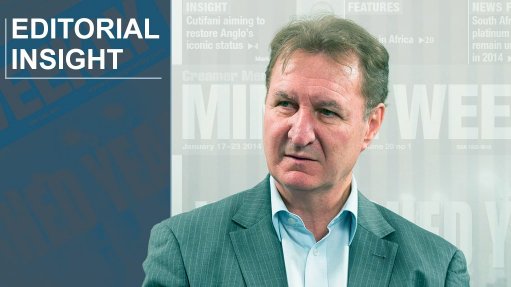
South Africa is obsessed with trying to prolong its old mining assets without setting out determinedly to replace them with new ones.
As renowned geologist Dr John Bristow and a growing number of South African geologists reiterate at conferences, mining depletes assets and without new discoveries, the industry that fuels the South African economy will grind to a halt sooner than many imagine.
Even though South Africa’s diamond sector is 150 years old this year and the gold industry is 131 years old, South Africa remains highly prospective, say those in the know, with more known value in the ground than any other country on earth. But it is all worth nothing if not properly delineated and brought to surface.
The problem is that few want to risk funding exploration and those that have the funds and want to explore are astonishingly prevented from doing so by the Department of Mineral Resources.
South Africa’s statutory Council for Geoscience is reportedly involved more in Africa than in South Africa, which, if true, means South Africa’s geology is not being scrutinised with state-of-the-art equipment, which makes all the difference.
It is beneficial that Sydney- and Johannesburg-listed company Orion Minerals last month initiated an airborne survey across a large area of the Northern Cape as part of a regional exploration programme that will make use of the latest available technology in an area that was last explored in the 1980s.
Electromagnetic methods have advanced significantly since the last systematic exploration took place in the Northern Cape belt and CEO Errol Smart believes that Orion has a rare opportunity to enhance value by carrying out advanced and early- stage projects at the same time.
The 962 km2 electromagnetic survey of the Areachap Belt will scrutinise a long stretch of highly prospective outcropping across many historically recorded zinc and copper occurrences to redress a lack of investigation below a depth of 300 m since South Africa’s former Anglovaal mining house discovered the Prieska deposit in 1968.
Now, following archive data reviews, the exploration team believes that Orion’s Northern Cape tenements, combined with the large Prieska Project already under way, position the company for rapid potential growth.
This should be a common narrative in South Africa, but it is not, despite Citibank’s calculations that South Africa has far more minerals and metals below the surface than both Russia and Australia.
Bristow reports that South Africa has not seen proper exploration with new technologies for about 40 years and cites this country’s last major discovery as the Venetia diamond mine in 1980.
This amounts to a serious dereliction of duty by the Department of Mineral Resources and the Council for Geoscience and emphasises the need for the private sector to establish the equivalent of the Prospectors & Developers Association of Canada to serve the interests of the people of South Africa.